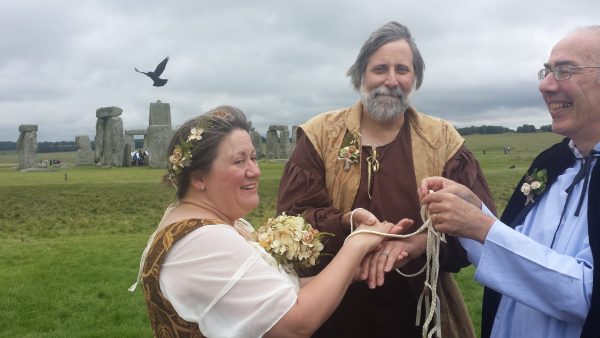The majority of people I come into contact with may have heard of “handfasting”, but don’t know what it is. They certainly don’t know how or why they can be part of a handfasting ceremony, and how it can enhance their event.
History
Its origins are pagan. No, there’s nothing sinister about paganism, by the way. It is nature-related (and nothing and nobody gets harmed!).
The idea of handfastings is medieval. It was a way for peasants (mostly), who were (almost by definition) too poor to afford to hire a clergyman, to be able to afford a marriage rite.
A cord was wrapped round the couple’s wrists until their union was consummated. Then they would keep it as a token of their love and commitment.
Up-to-date versions
As we look at modern times, the symbolism has remained the same. One difference, however, is that there are now essentially two types of handfasting.
One is a small (but significant) part of a wider ceremony; the other is one of the most important elements of an entire service.
It’s up to you how you are bound together. You can use a cord or ribbon, usually at least a metre in length, so it can be tied successfully. It can have several “heads”. Colours can be single or a variety. Choice can be based on personal preference or on what is considered auspicious for the couple. There are different ways to tie the cord/ribbon. I usually prefer an (eternity) figure-of-eight.
A Full Service
Although there is more than one way to put together a full service, you can agree what goes in with your celebrant beforehand.
There is likely to be the following, though:
Sanctifying the Circle
The circle symbolises the womb of Mother Earth and the idea is to make the ceremony site a holy place.
Elemental Blessings
Blessings in the four principal directions – these enable us to appreciate how the four elements help us on our journey.
Loving Cup
The couple may use their favourite drink quaffed from a loving cup (or “quaich”). This symbolises drinking in the promises or vows the couple has made.
The Handfasting
This is the symbolic binding of the hands. We get the terms “tying the knot” and “bonds of holy matrimony” from this. This act may only last a minute.
Jumping the Broom
This is another old custom, which is probably derived from American slave weddings. (For some people, it is therefore somewhat controversial.) It symbolises the creation of a new home together.
What a handfasting can add
The act of handfasting and the words that accompany it can be very beautiful. Moreover, the ritual stands out by its uniqueness and also the interplay and visible reactions of the couple.
The connection to nature is also highly significant.
Whatever the reason for including a handfasting, you are welcome to discuss it with me. Just give me a call.

